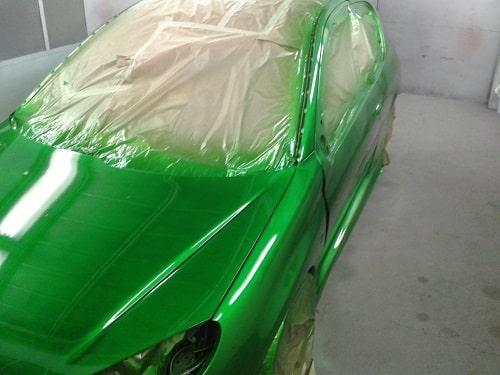All Products are in stock
and shipped from France.
Delivery within 48 hours.
and shipped from France.
Delivery within 48 hours.
Our categories
 Optimizing the shine of a car varnish
Optimizing the shine of a car varnish
The glossy and transparent finish has a protective role for the bodywork and the paint, and also an aesthetic role. Today the brilliance, the “gloss”, produced by bodywork varnishes is very high and easily reaches 95° of specular gloss. What are the rules and tips for obtaining perfectly taut glossy varnishes, "wet effects", mirror surfaces? Here we will not talk about the choice of automotive varnish, but focus on technique. A perfectly done nail polish should be beautiful, and you should never have to buff or polish artificially to achieve a perfect result.
First of all, some basic rules:
the mixture is done with the hardener and should be allowed to stand for 5 minutes before being sprayed. This allows better polymerization, and this contributes to the quality of hardening.
The ambient temperature or the paint booth must be monitored by the painter (between 15 and 25°C), because below, the solvents will be slow to escape, and above, they will not have time to escape before the film closes and traps them.
Once the application is finished, the ambient humidity is the worst enemy of a quality finish, because it can matify the entire surface. Ditto if you cook directly without waiting for 5-10 min to allow the evaporation of the solvents (desolvation), or if you cook too long or too hard!
How to keep the gloss of a bodywork varnish ?
The respect of the thickness is very important, and many ignore it. Depending on whether an HS or UHS type finish is used, the recommendations of the technical data sheet which indicates the final dry thickness must be respected. This is generally 50 microns dry, and it should not be exceeded at the risk of seeing the level of "gloss" buried and imprisoning the solvents.
So, it is not by multiplying the layers that we will obtain a better result, on the contrary!
UHS type bodywork varnishes are as shiny as HS varnishes. Their difference is that they make it possible to reach the final thickness more quickly because of their high dry matter content. An HS bodywork varnish is applied in two full coats, while a UHS varnish is applied in ½ coat, then one coat. To obtain a very shiny varnish, it is therefore necessary to apply the right quantity of varnish, neither more nor less.
Gloss is dependent on other factors such as proper air pressure, nozzle size and setting, distance to substrate.
 Types of varnishes and their drying
Types of varnishes and their drying
We must understand that there are varnishes intended to dry quickly, and others ultra quickly, in the air, without cooking. These varnishes give an excellent shine but should not be used on too large surfaces because they dry too quickly.
On the contrary, certain high-end varnishes are reserved for complete paintwork or luxury vehicles, and have a drying time. traditional "slow" which require cooking at a temperature of 40 to 60°C for 30 minutes.
How to obtain the most shiny varnish possible ?
This technique is recommended on dark backgrounds (the best is a pure black background, without mother-of-pearl or metal, nothing!):
It involves applying 2 to 3 coats of varnish each day, for several days: allow 24 hours of thorough drying between each varnishing and sanding with light water at 500 or 800 each time.
After 3 varnishing sessions, the surface gives an impression of very thick wet varnish. If we continue, the reflections from the outside on this lacquered mirror take precedence over the color of the background.
Avoiding defects on bodywork varnish
Applying varnish is delicate and requires a certain handling of the varnish, but above all scrupulous respect for the care of preparation and application. Many defects can occur, such as holes, micro-air bubbles, traces, drips, orange peel, lack of shine, detachment... Take a look at our guide "How to avoid defects on a bodywork varnish ? » Knowledge does not replace experience, but an experienced painter is worth two!
HS varnish
MS varnish
UHS varnish
Quick varnish
Bodywork varnish spray
Ceramic varnish














































































